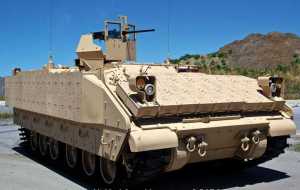| Designation: | Bradley BMV |
 |
|---|---|---|
| Manufacturer: | BAE Systems Land and Armament | |
| Product type: | Armoured Vehicles | |
| Name: | Self-propelled mortar |
The Bradley Mortar Vehicle is a Bradley A3 based variant which provides immediate fire support to the Heavy Brigade Combat Team (HBCT), including the armored and mechanized battalions and armored cavalry squadrons.
The high survivability and force protection of the BMV, at the same level as the Bradley A3, provides the capability of deployment closer to the battlefield. The increased interior space and the unique modularity of its stowage system enables the BMV to carry over 115 rounds of 120mm ammunition, which facilitates the crew’s ability to provide support for longer duration of sustainable fires.
The Bradley A3 digital architecture integrates current technologies enhancements, such as FBCB2 and the M95 fire control system. It also has the capability to accept future technological upgrades and growth.
The BMV’s increased mobility, force protection, survivability, and ammunition storage provide a significant increase in capabilities over the existing systems and any other potential replacement option.
- Armored Medical Evacuation Vehicle (AMEV)
- Armored Medical Treatment Vehicle (AMTV)
- Bradley Command Post (BCP), Bradley Mortar Vehicle (BMV)
- Bradley General Purpose Vehicle (BGPV)
BFoV platforms possess exceptional survivability against kinetic energy and artillery munitions.
With the common Bradley reactive armor installed, the BFoV will provide the same level of hand-held High-Explosive AntiTank (HEAT) and Anti-Tank Guided Missile (ATGM) protection as the BFV. BFoV platform design incorporates all of the Bradley Urban Survivability Kits (BUSK) that have been developed in response to the changing threat environment.
The BFoV variants are as mobile and agile as the platforms currently residing in the HBCT formation. This increased mobility over the M113 FoV provides the maneuver commander the freedom to execute operations without being hindered by the inability of his critical battlefield functions to keep up with the rest of the force.
BFoV replacements for the M113 FoV establishes 74% commonality across the HBCT formation thus reducing the HBCT logistics tail, simplifies crew and maintenance training and enables more efficient sustainment and capability upgrades.
The increase in available space provides the ability to integrate more capable MEPs for each mission role.
- M95 Fire Control System
- Modular ammo storage racks
- Modular turntable
- 115 mortars 120 mm or combination of 60 mm, 81mm and 120 mm
|
||||||||||||||||||||||||||||||||
